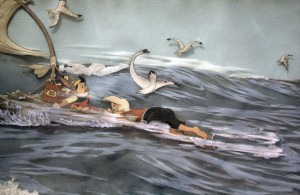Have you recently ventured into the Contemporary Gallery at the NBMAA? Wondering what the futuristic sound-dome is all about? LIsten in as the artist-mastermind behind The Road Not Taken, Jason Huff, and Curatorial Intern, Emily Sesko, discuss the work and muse about art and life.
Emily Sesko (ES): A few of your projects “zoom in” on an interaction between literature and algorithmic computer functions. How would you say your experiences with these projects, like “AutoSummarize” or “The Road Not Taken” have affected your perspective on literature, or have they not?
Jason Huff (JH): I think about literature differently now. I keep trying to imagine the 30 million or more books on Google Books, plus all of the other texts on sites like Project Gutenberg, and it’s overwhelming. When I created “AutoSummarize,” I was interested in Markov string generators and how computer algorithms could learn English-language grammars. I was curious to find the algorithms’ limits.
In “AutoSummarize,” I use Microsoft Word’s summary algorithm to create the summaries. It was absurd to me that software engineers had built a tool that would let users summarize any body of text to 1% of its original length. (Maybe it makes sense for business documents, but I’m still not convinced.) When I started using Word to summarize entire books, the results were unexpected. Suddenly, I was reminded of all the Cliffs Notes I read in high school, of classic books, only these summaries were even more succinct — ridiculously so. The summaries felt like parodies of the originals, but also true to the way reading and writing has changed over the years.
Microsoft added AutoSummarize to Word in 1997. Each new version includes some upgraded version of the function. There are some basic rules that apply to the summaries; word count, capitalization, etc. Outside of those rules, the algorithm is a bit of a mystery. Making the work was my way of trying to understand two things: one, how Word’s AutoSummarize function produces its summaries, and two, how an algorithm can tell stories.
To me, it is fascinating that algorithms are making content decisions. It’s not a big secret; everyone knows that algorithms power things like Google Search and grammar-correcting word-processing programs. What is interesting is how often people take these complicated equations for granted. If we start to think of them as authors of content — or co-authors — that collaborate with us to generate meaning and poetry, things start to get a lot more interesting. “The Road Not Taken” really points to this idea. It asks viewers to pause and think about the millions of other people and entities who co-create search suggestions, including the algorithm itself, their own personal search histories and current location notwithstanding. The scale of conditional factors is really tremendous, and the way the resulting prosaic language (in the case of Google search suggestions) is presented is meant to feel like a default choice. It’s designed to be seen and clicked, but not really thought about. It’s like Google saying, “Follow the easy paths. We know you like them.”
So I think there is a second author hiding in plain sight, and remixing not only our very interesting historic literature, but also the everyday junk language we use to search the Web. I think phenomena like Google search suggestions are just as influential to pop culture as a pop-novelist whose writing reflects a particular moment. Our own everyday story is being told back to us in these fractured web- and software interfaces all the time. It is its own kind of literature. (more…)
Read Full Post »











